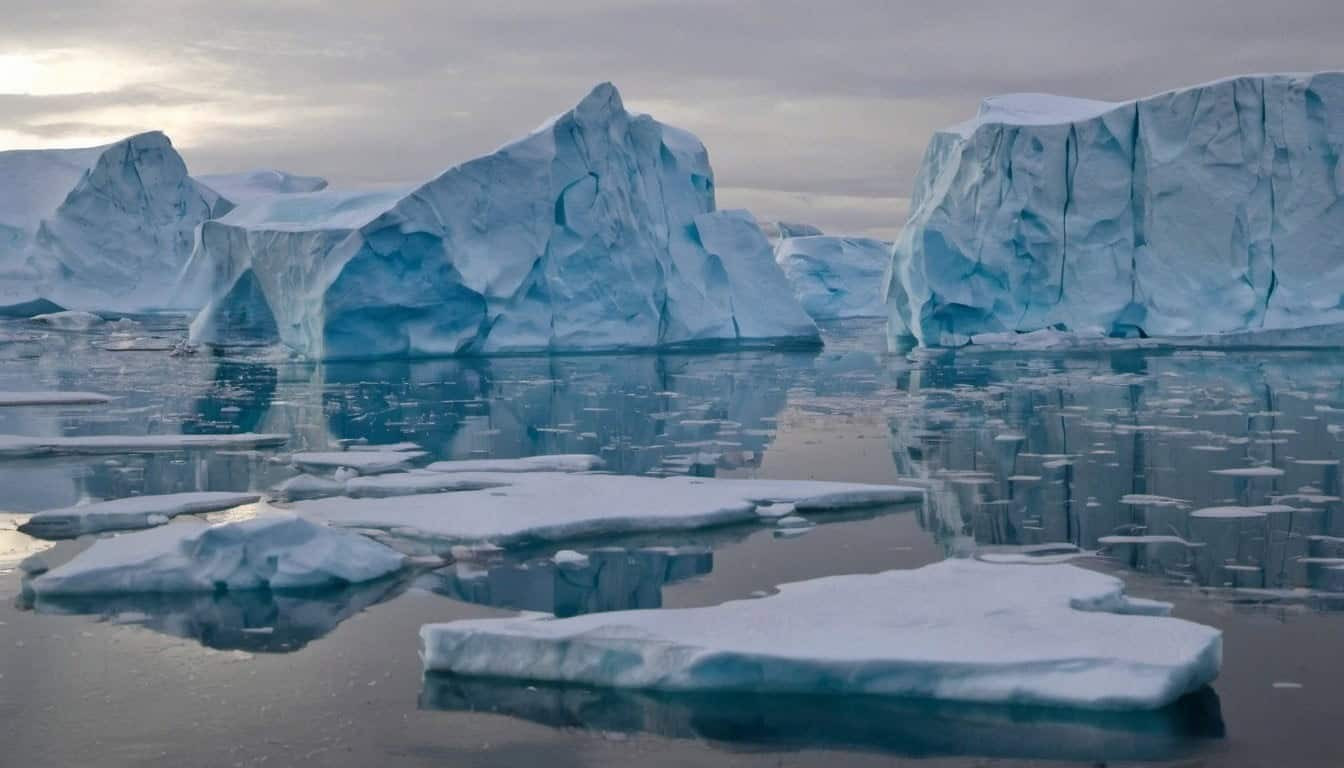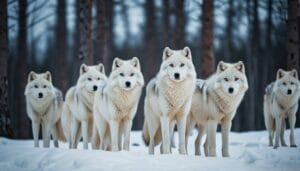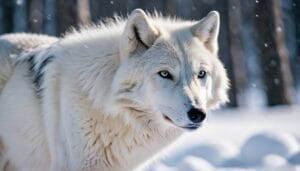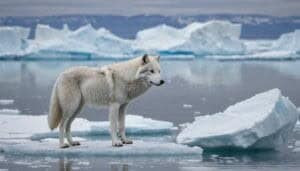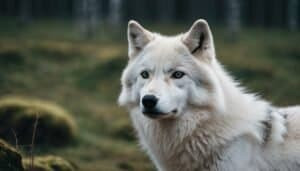Introduction
The Arctic wolf, a resilient predator adapted to the harsh Arctic environment, faces increasing threats due to climate change
This article explores the primary challenges these wolves encounter, including habitat loss and changes in prey availability, and examines the effective conservation strategies employed to mitigate these impacts
Additionally, we delve into the role of technology and policy in supporting these efforts, highlight successful case studies, and discuss future prospects for Arctic wolf conservation
Primary Threats and Conservation Strategies for Arctic Wolves
The Arctic wolf, a subspecies of the gray wolf, is uniquely adapted to the frigid Arctic environment. However, the rapid pace of climate change presents significant challenges that threaten its survival
In this section, we will discuss the primary threats faced by Arctic wolves and the conservation strategies implemented to mitigate these impacts
Habitat Loss and Degradation
One of the most pressing threats to Arctic wolves is habitat loss and degradation
The melting of polar ice due to rising global temperatures is drastically altering the Arctic landscape. According to a study published in Nature Communications (2021), the Arctic is warming at more than twice the global average rate, leading to significant reductions in sea ice and permafrost
As the ice melts, the terrestrial habitat that Arctic wolves depend on is shrinking. This habitat loss affects not only the wolves but also the entire Arctic ecosystem, disrupting the delicate balance of predator and prey dynamics. Conservationists are working to preserve and restore critical habitats by advocating for protected areas and sustainable land use practices
For instance, the establishment of large protected zones, such as the Arctic National Wildlife Refuge, helps safeguard the remaining habitats crucial for the survival of Arctic wolves and other wildlife
Changes in Prey Availability
Climate change is also affecting the availability and distribution of prey species for Arctic wolves
The primary prey for these wolves includes Arctic hares, musk oxen, and caribou. As temperatures rise, the migration patterns and population dynamics of these prey species are shifting. Research indicates that caribou populations, in particular, are declining due to changes in vegetation and increased insect harassment during warmer summers
To address this issue, conservationists are focusing on monitoring prey populations and implementing measures to support their survival
This includes habitat management practices that ensure the availability of food resources and the creation of corridors that facilitate the movement and migration of prey species. Additionally, efforts to control invasive species that compete with native prey are crucial in maintaining the ecological balance necessary for Arctic wolves to thrive
Increased Human-Wildlife Conflict
As the Arctic becomes more accessible due to melting ice, human activities such as oil and gas exploration, shipping, and tourism are increasing
This rise in human presence leads to greater human-wildlife conflict, with Arctic wolves often coming into direct contact with humans. These encounters can result in wolves being killed or displaced from their natural habitats
Conservation strategies to mitigate human-wildlife conflict include creating buffer zones around critical habitats, enforcing regulations that limit human activities in sensitive areas, and promoting coexistence through community engagement and education programs
For example, conservationists work with local communities to develop practices that minimize wolf-human interactions, such as proper waste management and the use of deterrents to keep wolves away from settlements
Habitat Preservation and Restoration
Preserving and restoring habitats are fundamental strategies in conserving Arctic wolves. Conservationists employ various techniques to protect and rehabilitate the Arctic environment
One approach is the designation of protected areas, which restricts human activities and provides a safe haven for wildlife. The use of reforestation and revegetation projects helps restore degraded landscapes, promoting biodiversity and resilience against climate change
In addition to these efforts, conservationists are exploring innovative methods such as assisted migration, where species are relocated to more suitable habitats as their current environments become inhospitable. This controversial yet increasingly considered strategy aims to preemptively move Arctic wolves and other species to areas where they can better cope with changing climatic conditions
Anti-Poaching Measures
Poaching remains a significant threat to Arctic wolves, driven by demand for their fur and other body parts. To combat this, conservationists are implementing anti-poaching measures, including increased patrolling, the use of surveillance technology, and harsher penalties for offenders
Community-based anti-poaching initiatives involve training and employing local people as wildlife guardians, fostering a sense of ownership and responsibility for protecting the wolves
Community Involvement and Education
Local communities play a crucial role in Arctic wolf conservation. By involving indigenous and local populations in conservation efforts, conservationists can leverage traditional knowledge and practices that have sustainably managed these ecosystems for generations
Education programs aimed at raising awareness about the importance of Arctic wolves and the threats they face are essential in fostering community support and participation
Community involvement also extends to participatory monitoring programs, where locals assist in tracking wolf populations and reporting sightings. This collaborative approach not only enhances the effectiveness of conservation efforts but also empowers communities to become stewards of their natural heritage
By addressing the primary threats through a combination of habitat preservation, monitoring, anti-poaching efforts, and community engagement, conservationists are making significant strides in mitigating the effects of climate change on Arctic wolves
However, the success of these strategies depends on continuous adaptation and collaboration among scientists, policymakers, and local communities
Role of Technology and Policy in Arctic Wolf Conservation
Technological advancements and supportive policies play a crucial role in the conservation of Arctic wolves. These tools and frameworks enable more effective monitoring, research, and protection measures, ensuring the survival of this keystone species in a rapidly changing environment
Tracking and Monitoring Systems
The implementation of advanced tracking and monitoring systems is essential for studying Arctic wolf populations and their movements
GPS collars, for example, provide real-time data on wolf locations, migration patterns, and habitat use. This information is vital for identifying critical habitats, understanding how wolves interact with their environment, and detecting potential threats
A study published in Biological Conservation (2020) highlighted the effectiveness of using GPS collars to monitor Arctic wolf populations in Canada’s northern territories. The data collected helped conservationists identify key areas for protection and allowed for the timely detection of potential conflicts with human activities
Additionally, remote sensing technologies such as satellite imagery and drones offer invaluable insights into habitat changes and environmental conditions. These tools enable large-scale monitoring of the Arctic landscape, helping researchers track the effects of climate change on wolf habitats and prey availability
Use of Drones and Satellite Imagery
Drones and satellite imagery have revolutionized wildlife monitoring by providing detailed and up-to-date information about remote and inaccessible areas
Drones, equipped with high-resolution cameras and thermal imaging, can capture images and videos of Arctic wolves and their habitats without disturbing the animals. This non-invasive method is particularly useful for observing wolf behavior and detecting den sites
Satellite imagery, on the other hand, allows for continuous and extensive monitoring of the Arctic region. It can detect changes in vegetation, ice cover, and land use, providing crucial data for assessing the impact of climate change on Arctic wolf habitats
According to a study in Remote Sensing of Environment (2019), satellite imagery has been instrumental in tracking habitat loss and fragmentation in the Arctic, guiding conservation efforts towards the most affected areas
Genetic Research and Breeding Programs
Genetic research plays a significant role in understanding the health and diversity of Arctic wolf populations. By analyzing DNA samples, scientists can assess genetic diversity, identify inbreeding risks, and develop strategies to maintain healthy populations
A study published in Conservation Genetics (2021) revealed that Arctic wolves exhibit lower genetic diversity compared to other wolf populations, highlighting the need for targeted conservation actions
Breeding programs, although less common for wild populations, are sometimes considered for critically endangered species. These programs involve captive breeding and subsequent reintroduction into the wild, aimed at boosting population numbers and genetic diversity. While controversial, such programs can serve as a last resort for species on the brink of extinction
Global Agreements and Initiatives
International cooperation is vital for the conservation of Arctic wolves, given that these animals roam across borders
Global agreements and initiatives provide frameworks for collaborative efforts to address climate change and its impacts on Arctic wildlife. One such initiative is the Arctic Council, which includes member states and indigenous communities working together to promote sustainable development and environmental protection in the Arctic
The Convention on Biological Diversity (CBD) is another critical framework that encourages countries to develop and implement conservation strategies for biodiversity, including Arctic species. These international agreements facilitate the sharing of knowledge, resources, and best practices, enhancing the effectiveness of conservation efforts
Role of NGOs and Conservation Organizations
Non-governmental organizations (NGOs) and conservation organizations play a pivotal role in Arctic wolf conservation. These entities often lead research projects, advocate for policy changes, and implement on-the-ground conservation initiatives
Organizations like the World Wildlife Fund (WWF) and the Wildlife Conservation Society (WCS) have been actively involved in protecting Arctic wildlife and habitats
For example, the WWF’s Arctic Program focuses on mitigating climate change impacts, protecting critical habitats, and promoting sustainable development in the Arctic. Through partnerships with governments, indigenous communities, and other stakeholders, these organizations drive comprehensive conservation efforts that benefit Arctic wolves and the broader ecosystem
Government Policies and Regulations
Effective government policies and regulations are essential for the conservation of Arctic wolves
These policies can include protective legislation, funding for research and conservation programs, and enforcement of anti-poaching laws. Governments can also establish protected areas and wildlife corridors to ensure the long-term survival of Arctic wolves
For instance, Canada has implemented the Species at Risk Act (SARA), which provides legal protection for endangered species, including Arctic wolves. The act mandates the development of recovery strategies and action plans to restore and maintain healthy populations. Such policies, supported by scientific research and community involvement, are crucial for successful conservation outcomes
By leveraging technology and implementing supportive policies, conservationists can enhance their efforts to protect Arctic wolves
These strategies not only address the immediate threats posed by climate change but also promote the resilience and adaptability of Arctic wolf populations in the face of ongoing environmental changes
Case Studies and Success Stories
Examining case studies and success stories provides valuable insights into effective conservation strategies for Arctic wolves. By learning from successful programs and initiatives, conservationists can refine their approaches and increase the likelihood of achieving positive outcomes for Arctic wolf populations
Successful Conservation Programs
Several conservation programs have demonstrated significant success in protecting Arctic wolves and their habitats. One notable example is the Arctic Wolf Recovery Project in Canada, which focuses on habitat preservation, monitoring, and community engagement
The project, managed by the Wildlife Conservation Society (WCS), has implemented several key strategies, including the establishment of protected areas and habitat corridors
These efforts aim to safeguard critical wolf habitats from human encroachment and ensure the availability of prey species. According to a report by the WCS, the project has led to a notable increase in Arctic wolf populations in the protected areas, showcasing the effectiveness of habitat conservation
Another successful program is the Arctic Biodiversity Assessment (ABA), conducted by the Conservation of Arctic Flora and Fauna (CAFF). The ABA provides a comprehensive overview of Arctic biodiversity, including Arctic wolves, and offers recommendations for conservation actions
The assessment has been instrumental in guiding policy decisions and prioritizing conservation efforts across the Arctic region
Lessons Learned from Other Arctic Species
Lessons learned from the conservation of other Arctic species can be applied to Arctic wolves
For instance, the successful conservation of the polar bear, another iconic Arctic predator, offers valuable insights. The Polar Bear Conservation Strategy, implemented by the U.S. Fish and Wildlife Service (USFWS), focuses on habitat protection, climate change mitigation, and international cooperation
Key elements of the strategy include monitoring polar bear populations, reducing greenhouse gas emissions, and collaborating with Arctic communities. These strategies have contributed to the stabilization of polar bear populations in some regions, demonstrating the importance of a multifaceted approach to conservation
Similarly, the conservation efforts for the Arctic char, a fish species that shares the Arctic environment with wolves, highlight the benefits of habitat protection and sustainable management practices
The success of these programs underscores the importance of addressing habitat degradation and ensuring the sustainability of prey species
Future Prospects and Innovations
Looking forward, future prospects for Arctic wolf conservation include the adoption of innovative technologies and approaches
One promising area is the use of artificial intelligence (AI) and machine learning for analyzing large datasets and predicting future habitat changes. These technologies can enhance the accuracy of population models and help conservationists anticipate the impacts of climate change
Another innovation is the development of genetic tools to assess and enhance genetic diversity within Arctic wolf populations. Advances in genomics and reproductive technology could potentially aid in managing genetic diversity and reducing the risk of inbreeding
Additionally, increased international collaboration and funding are crucial for supporting long-term conservation efforts. Strengthening partnerships between governments, NGOs, and indigenous communities can enhance the effectiveness of conservation strategies and promote the resilience of Arctic ecosystems
By leveraging successful case studies, learning from other species, and embracing new technologies, conservationists can improve their efforts to protect Arctic wolves and ensure their survival in a changing climate
Conclusion
The Arctic wolf faces significant challenges due to climate change, but through dedicated conservation efforts, there is hope for mitigating these impacts
This article has explored the primary threats to Arctic wolves, such as habitat loss, changes in prey availability, and increased human-wildlife conflict. It has also highlighted various conservation strategies including habitat preservation, anti-poaching measures, and community involvement
Moreover, the role of technology and policy in Arctic wolf conservation has been discussed, emphasizing the importance of tracking systems, genetic research, and international cooperation. Successful case studies and lessons from other Arctic species provide valuable insights that can guide future conservation efforts
By combining habitat protection, technological innovations, supportive policies, and community engagement, conservationists can create a multifaceted approach to ensure the survival of Arctic wolves
Continuous adaptation and collaboration among scientists, policymakers, and local communities are essential for addressing the ongoing challenges posed by climate change and securing a future for these resilient predators in their Arctic home
